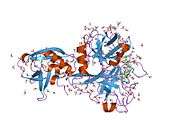HPN (gene)
| Hepsin-SRCR | |||||||||
|---|---|---|---|---|---|---|---|---|---|
 extracellular domain of human hepsin | |||||||||
| Identifiers | |||||||||
| Symbol | Hepsin-SRCR | ||||||||
| Pfam | PF09272 | ||||||||
| InterPro | IPR015352 | ||||||||
| SCOP | 1p57 | ||||||||
| SUPERFAMILY | 1p57 | ||||||||
| |||||||||
Serine protease hepsin is an enzyme that in humans is encoded by the HPN gene.[5][6]
Function
Hepsin is a cell surface serine protease.[6]
Hepson contains a peptidase S1 domain and an SRCR domain. The SRCR domain is located in the extracellular part of the protein, it is formed primarily by three elements of regular secondary structure: a 12-residue alpha helix, a twisted five-stranded antiparallel beta sheet, and a second, two-stranded, antiparallel sheet. The two beta-sheets lie at roughly right angles to each other, with the helix nestled between the two, adopting an SRCR fold. The exact function of this domain has not been identified, though it probably may serve to orient the protease domain or place it in the vicinity of its substrate.[7]
Clinical significance
Hepsin expression is unregulated in prostate cancer and correlates with disease progression.[8]
References
- 1 2 3 GRCh38: Ensembl release 89: ENSG00000105707 - Ensembl, May 2017
- 1 2 3 GRCm38: Ensembl release 89: ENSMUSG00000001249 - Ensembl, May 2017
- ↑ "Human PubMed Reference:".
- ↑ "Mouse PubMed Reference:".
- ↑ Leytus SP, Loeb KR, Hagen FS, Kurachi K, Davie EW (Feb 1988). "A novel trypsin-like serine protease (hepsin) with a putative transmembrane domain expressed by human liver and hepatoma cells". Biochemistry. 27 (3): 1067–74. PMID 2835076. doi:10.1021/bi00403a032.
- 1 2 "Entrez Gene: HPN hepsin (transmembrane protease, serine 1)".
- ↑ Somoza JR, Ho JD, Luong C, Ghate M, Sprengeler PA, Mortara K, Shrader WD, Sperandio D, Chan H, McGrath ME, Katz BA (Sep 2003). "The structure of the extracellular region of human hepsin reveals a serine protease domain and a novel scavenger receptor cysteine-rich (SRCR) domain". Structure. 11 (9): 1123–31. PMID 12962630. doi:10.1016/S0969-2126(03)00148-5.
- ↑ Wu Q, Parry G (2007). "Hepsin and prostate cancer". Frontiers in Bioscience. 12: 5052–9. PMID 17569629. doi:10.2741/2447.
Further reading
- Wu Q (Feb 2001). "Gene targeting in hemostasis. Hepsin". Frontiers in Bioscience. 6: D192–200. PMID 11171558.
- Tsuji A, Torres-Rosado A, Arai T, Le Beau MM, Lemons RS, Chou SH, Kurachi K (Sep 1991). "Hepsin, a cell membrane-associated protease. Characterization, tissue distribution, and gene localization". The Journal of Biological Chemistry. 266 (25): 16948–53. PMID 1885621.
- Kazama Y, Hamamoto T, Foster DC, Kisiel W (Jan 1995). "Hepsin, a putative membrane-associated serine protease, activates human factor VII and initiates a pathway of blood coagulation on the cell surface leading to thrombin formation". The Journal of Biological Chemistry. 270 (1): 66–72. PMID 7814421. doi:10.1074/jbc.270.1.66.
- Torres-Rosado A, O'Shea KS, Tsuji A, Chou SH, Kurachi K (Aug 1993). "Hepsin, a putative cell-surface serine protease, is required for mammalian cell growth". Proceedings of the National Academy of Sciences of the United States of America. 90 (15): 7181–5. PMC 47100
 . PMID 8346233. doi:10.1073/pnas.90.15.7181.
. PMID 8346233. doi:10.1073/pnas.90.15.7181. - Chen Z, Fan Z, McNeal JE, Nolley R, Caldwell MC, Mahadevappa M, Zhang Z, Warrington JA, Stamey TA (Apr 2003). "Hepsin and maspin are inversely expressed in laser capture microdissectioned prostate cancer". The Journal of Urology. 169 (4): 1316–9. PMID 12629351. doi:10.1097/01.ju.0000050648.40164.0d.
- Somoza JR, Ho JD, Luong C, Ghate M, Sprengeler PA, Mortara K, Shrader WD, Sperandio D, Chan H, McGrath ME, Katz BA (Sep 2003). "The structure of the extracellular region of human hepsin reveals a serine protease domain and a novel scavenger receptor cysteine-rich (SRCR) domain". Structure. 11 (9): 1123–31. PMID 12962630. doi:10.1016/S0969-2126(03)00148-5.
- Kirchhofer D, Peek M, Lipari MT, Billeci K, Fan B, Moran P (Mar 2005). "Hepsin activates pro-hepatocyte growth factor and is inhibited by hepatocyte growth factor activator inhibitor-1B (HAI-1B) and HAI-2". FEBS Letters. 579 (9): 1945–50. PMID 15792801. doi:10.1016/j.febslet.2005.01.085.
- Pal P, Xi H, Kaushal R, Sun G, Jin CH, Jin L, Suarez BK, Catalona WJ, Deka R (Sep 2006). "Variants in the HEPSIN gene are associated with prostate cancer in men of European origin". Human Genetics. 120 (2): 187–92. PMID 16783571. doi:10.1007/s00439-006-0204-3.
- Moran P, Li W, Fan B, Vij R, Eigenbrot C, Kirchhofer D (Oct 2006). "Pro-urokinase-type plasminogen activator is a substrate for hepsin". The Journal of Biological Chemistry. 281 (41): 30439–46. PMID 16908524. doi:10.1074/jbc.M605440200.
- Betsunoh H, Mukai S, Akiyama Y, Fukushima T, Minamiguchi N, Hasui Y, Osada Y, Kataoka H (Apr 2007). "Clinical relevance of hepsin and hepatocyte growth factor activator inhibitor type 2 expression in renal cell carcinoma". Cancer Science. 98 (4): 491–8. PMID 17309599. doi:10.1111/j.1349-7006.2007.00412.x.
This article incorporates text from the public domain Pfam and InterPro IPR015352








